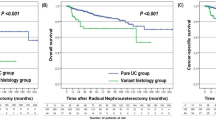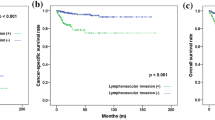Abstract
Purpose
To evaluate the association between tumor squamous and/or glandular differentiation and tumor biological characteristics and to validate the impact of these histologic variants on oncologic outcomes of UTUC patients.
Methods
We retrospectively analyzed the data of 687 UTUC patients who underwent radical nephroureterectomy in our institute, from Aug 1, 1999, to Dec 31, 2011. All pathologic sections were reevaluated for histologic differentiation variations (squamous and glandular). The clinicopathological variables of patients were reviewed.
Results
Among the 687 UTUC patients in our study, 53 (7.7 %) had squamous differentiation, 20 (2.9 %) had glandular differentiation and 8 (1.2 %) had both histologic variants. Patients with mixed histologic variant tended to have significant larger percentage of sessile tumor architecture (58.0 vs 18.2 %), presence of CIS (7.4 vs 2.3 %), advanced T stage, advanced tumor grade and lymph node metastasis (17.3 vs 6.6 %; all p < 0.05). Patients with squamous and/or glandular differentiation had significant worse cancer-specific survival than pure UTUC patients (p < 0.001), while significant difference of recurrence-free survival between two groups was not observed (p = 0.126). Patients with both squamous and glandular differentiation did not show significantly worse CSS than those with single histologic variant. Univariate analyses revealed that tumor squamous and/or glandular differentiation was a significant factor on survival (p < 0.001). However, the influence did not remain significant after adjusted for other factors in the multivariate analyses (p = 0.076, HR 1.42).
Conclusions
UTUC patients with squamous and/or glandular differentiation are more likely to have aggressive tumor biological features and tend to have worse postoperative outcomes.


Similar content being viewed by others
References
Roupret M, Babjuk M, Comperat E, Zigeuner R, Sylvester R, Burger M, Cowan N, Bohle A, Van Rhijn BW, Kaasinen E, Palou J, Shariat SF (2013) European guidelines on upper tract urothelial carcinomas: 2013 update. Eur Urol 63:1059–1071
Siegel R, Naishadham D, Jemal A (2013) Cancer statistics, 2013. CA Cancer J Clin 63:11–30
Munoz JJ, Ellison LM (2000) Upper tract urothelial neoplasms: incidence and survival during the last 2 decades. J Urol 164:1523–1525
Kim SP, Frank I, Cheville JC, Thompson RH, Weight CJ, Thapa P, Boorjian SA (2012) The impact of squamous and glandular differentiation on survival after radical cystectomy for urothelial carcinoma. J Urol 188:405–409
Black PC, Brown GA, Dinney CP (2009) The impact of variant histology on the outcome of bladder cancer treated with curative intent. Urol Oncol 27:3–7
Zigeuner R, Shariat SF, Margulis V, Karakiewicz PI, Roscigno M, Weizer A, Kikuchi E, Remzi M, Raman JD, Bolenz C, Bensalah K, Capitanio U, Koppie TM, Kassouf W, Sircar K, Patard JJ, Fernandez MI, Wood CG, Montorsi F, Strobel P, Wheat JC, Haitel A, Oya M, Guo CC, Ng C, Chade DC, Sagalowsky A, Langner C (2010) Tumour necrosis is an indicator of aggressive biology in patients with urothelial carcinoma of the upper urinary tract. Eur Urol 57:575–581
Seitz C, Gupta A, Shariat SF, Matsumoto K, Kassouf W, Walton TJ, Fritsche HM, Otto W, Tritschler S, Bastian PJ, Carballido J, Ficarra V, Karakiewicz PI, Artibani W, Mazzoleni G, Novara G (2010) Association of tumor necrosis with pathological features and clinical outcome in 754 patients undergoing radical nephroureterectomy for upper tract urothelial carcinoma: an international validation study. J Urol 184:1895–1900
Simone G, Papalia R, Loreto A, Leonardo C, Sentinelli S, Gallucci M (2009) Independent prognostic value of tumour diameter and tumour necrosis in upper urinary tract urothelial carcinoma. BJU Int 103:1052–1057
Lee SE, Hong SK, Han BK, Yu JH, Han JH, Jeong SJ, Byun SS, Park YH, Choe G (2007) Prognostic significance of tumor necrosis in primary transitional cell carcinoma of upper urinary tract. Jpn J Clin Oncol 37:49–55
Sobin LH, Wittekind C (2002) TNM Classification of malignant tumours. Wiley, New York
Mostofi FK, Sobin LH, Tosoni I (1973) Histological typing of urinary bladder tumours. International histological classification of tumours, No 19. World Health Organisation, Geneva
Eble JN, Sauter G, Epstein JI, Sesterhenn IA (2004) World Health Organisation classification of tumours. Tumours of the urinary system and male genital organs. IARC Press, Lyon
Lopez-Beltran A, Cheng L (2006) Histologic variants of urothelial carcinoma: differential diagnosis and clinical implications. Hum Pathol 37:1371–1388
Lee YJ, Moon KC, Jeong CW, Kwak C, Kim HH, Ku JH (2014) Impact of squamous and glandular differentiation on oncologic outcomes in upper and lower tract urothelial carcinoma. PLoS One 9:e107027
Xylinas E, Rink M, Robinson BD, Lotan Y, Babjuk M, Brisuda A, Green DA, Kluth LA, Pycha A, Fradet Y, Faison T, Lee RK, Karakiewicz PI, Zerbib M, Scherr DS, Shariat SF (2013) Impact of histological variants on oncological outcomes of patients with urothelial carcinoma of the bladder treated with radical cystectomy. Eur J Cancer 49:1889–1897
Rink M, Robinson BD, Green DA, Cha EK, Hansen J, Comploj E, Margulis V, Raman JD, Ng CK, Remzi M, Bensalah K, Kabbani W, Haitel A, Rioux-Leclercq N, Guo CC, Chun FK, Kikuchi E, Kassouf W, Sircar K, Sun M, Sonpavde G, Lotan Y, Pycha A, Karakiewicz PI, Scherr DS, Shariat SF (2012) Impact of histological variants on clinical outcomes of patients with upper urinary tract urothelial carcinoma. J Urol 188:398–404
Perez-Montiel D, Wakely PE, Hes O, Michal M, Suster S (2006) High-grade urothelial carcinoma of the renal pelvis: clinicopathologic study of 108 cases with emphasis on unusual morphologic variants. Mod Pathol 19:494–503
Fang D, Zhang L, Li X, Xiong G, Chen X, Han W, He Z, Zhou L (2014) Risk factors and treatment outcomes of new contralateral upper urinary urothelial carcinoma after nephroureterectomy: the experiences of a large Chinese center. J Cancer Res Clin Oncol 140:477–485
Chen XP, Xiong GY, Li XS, Matin SF, Garcia M, Fang D, Wang TY, Yu W, Gong K, Song Y, He ZS, He Q, Zhou LQ (2013) Predictive factors for worse pathological outcomes of upper tract urothelial carcinoma: experience from a nationwide high-volume centre in China. BJU Int 112:917–924
Nortier JL, Martinez MC, Schmeiser HH, Arlt VM, Bieler CA, Petein M, Depierreux MF, De Pauw L, Abramowicz D, Vereerstraeten P, Vanherweghem JL (2000) Urothelial carcinoma associated with the use of a Chinese herb (Aristolochia fangchi). N Engl J Med 342:1686–1692
Cosyns JP, Jadoul M, Squifflet JP, Van Cangh PJ, van Ypersele DSC (1994) Urothelial malignancy in nephropathy due to Chinese herbs. Lancet 344:188
Cukuranovic R, Ignjatovic I, Visnjic M, Velickovic LJ, Petrovic B, Potic M, Stefanovic V (2010) Characteristics of upper urothelial carcinoma in an area of Balkan endemic nephropathy in south Serbia. A fifty-year retrospective study. Tumori 96:674–679
Pons F, Orsola A, Morote J, Bellmunt J (2011) Variant forms of bladder cancer: basic considerations on treatment approaches. Curr Oncol Rep 13:216–221
Holmang S, Lele SM, Johansson SL (2007) Squamous cell carcinoma of the renal pelvis and ureter: incidence, symptoms, treatment and outcome. J Urol 178:51–56
Abdollah F, Sun M, Jeldres C, Schmitges J, Thuret R, Djahangirian O, Tian Z, Shariat SF, Perrotte P, Montorsi F, Karakiewicz PI (2012) Survival after radical cystectomy of non-bilharzial squamous cell carcinoma vs urothelial carcinoma: a competing-risks analysis. BJU Int 109:564–569
Lughezzani G, Sun M, Jeldres C, Alasker A, Budaus L, Shariat SF, Latour M, Widmer H, Duclos A, Jolivet-Tremblay M, Montorsi F, Perrotte P, Karakiewicz PI (2010) Adenocarcinoma versus urothelial carcinoma of the urinary bladder: comparison between pathologic stage at radical cystectomy and cancer-specific mortality. Urology 75:376–381
Rink M, Adam M, Hansen J, Chun FK, Ahyai SA, Remzi M, Schlomm T, Engel O, Heuer R, Eichelberg C, Fisch M, Dahlem R, Shariat SF (2012) Upper tract urothelial carcinoma. An update on clinical and pathological prognostic factors. Urologe A 51:1228–1239
Scosyrev E, Ely BW, Messing EM, Speights VO, Grossman HB, Wood DP, de Vere WR, Vogelzang NJ, Trump DL, Natale RB, Tangen CM, Crawford ED, Thompson IM (2011) Do mixed histological features affect survival benefit from neoadjuvant platinum-based combination chemotherapy in patients with locally advanced bladder cancer? A secondary analysis of Southwest Oncology Group-Directed Intergroup Study (S8710). BJU Int 108:693–699
Logothetis CJ, Johnson DE, Chong C, Dexeus FH, Sella A, Ogden S, Smith T, Swanson DA, Babaian RJ, Wishnow KI, Et A (1988) Adjuvant cyclophosphamide, doxorubicin, and cisplatin chemotherapy for bladder cancer: an update. J Clin Oncol 6:1590–1596
Acknowledgments
This work was supported by grants from the Clinical Features Research of Capital (No. Z151100004015173), the Natural Science Foundation of Beijing (7152146) and the Collaborative Research Foundation of Peking University Health Science Center and National Taiwan University, College of Medicine (BMU20120318).
Authors’ contribution
Qi Tang involved in protocol/project development, data collection and management, drafting the manuscript and data analysis. Gengyan Xiong involved in protocol/project development, data collection or management, drafting the manuscript and data analysis. Xuesong Li involved in protocol/project development, revision of the manuscript and supervision. Dong Fang involved in data collection and management and revision of the manuscript. Chenguang Xi involved in data collection and management. Lei Zhang involved in data collection and management. Kaiwei Yang involved in data collection and management. Lin Yao involved in revision of the manuscript. Cuijian Zhang involved in revision of the manuscript. Wei Yu involved in revision of the manuscript. Qun He involved in protocol/project development. Kan Gong involved in protocol/project development. Zhisong He involved in protocol/project development. Liqun Zhou involved in protocol/project development and supervision.
Author information
Authors and Affiliations
Corresponding authors
Ethics declarations
Conflict of interest
The authors declare that there is no conflict of interests regarding the publication of this paper.
Research involving human participants and/or animals
Not involved.
Informed consent
All patients had signed consent forms to authorize the analysis of their medical records. The institutional review board approved this study.
Additional information
Qi Tang and Gengyan Xiong have contributed equally to this work.
Rights and permissions
About this article
Cite this article
Tang, Q., Xiong, G., Li, X. et al. The prognostic impact of squamous and glandular differentiation for upper tract urothelial carcinoma patients after radical nephroureterectomy. World J Urol 34, 871–877 (2016). https://doi.org/10.1007/s00345-015-1715-0
Received:
Accepted:
Published:
Issue Date:
DOI: https://doi.org/10.1007/s00345-015-1715-0




